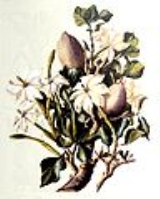
Gardenia thunbergia
Encyclopedia
Gardenia thunbergia is a shrub or small tree found in forest or on forest margins, occurring in the Eastern Cape
, Natal and Transkei
in South Africa. Densely twiggy and rigid with smooth light-grey bark. The leaves are smooth, shiny, whorled and entire, and clustered at the ends of branchlets. The profusely-borne flowers are large, white, extremely fragrant and about 70mm in diameter with long tubes only accessible to the probosces of nocturnal hawkmoths. The fruits are hard, woody, and fibrous, about 80mm long and about 40mm in diameter, light-grey with small raised white spots and can persist on the tree for some years if not browsed by elephant or antelope.
Gardenia thunbergia was first introduced to Kew as early as 1773. It belongs to the very large family of Rubiaceae
, which includes plants such as coffee (Coffea arabica
), quinine (Cinchona
) and numerous ornamental trees and shrubs with showy flowers.

Eastern Cape
The Eastern Cape is a province of South Africa. Its capital is Bhisho, but its two largest cities are Port Elizabeth and East London. It was formed in 1994 out of the "independent" Xhosa homelands of Transkei and Ciskei, together with the eastern portion of the Cape Province...
, Natal and Transkei
Transkei
The Transkei , officially the Republic of Transkei , was a Bantustan—an area set aside for members of a specific ethnicity—and nominal parliamentary democracy in the southeastern region of South Africa...
in South Africa. Densely twiggy and rigid with smooth light-grey bark. The leaves are smooth, shiny, whorled and entire, and clustered at the ends of branchlets. The profusely-borne flowers are large, white, extremely fragrant and about 70mm in diameter with long tubes only accessible to the probosces of nocturnal hawkmoths. The fruits are hard, woody, and fibrous, about 80mm long and about 40mm in diameter, light-grey with small raised white spots and can persist on the tree for some years if not browsed by elephant or antelope.
Gardenia thunbergia was first introduced to Kew as early as 1773. It belongs to the very large family of Rubiaceae
Rubiaceae
The Rubiaceae is a family of flowering plants, variously called the coffee family, madder family, or bedstraw family. The group contains many commonly known plants, including the economically important coffee , quinine , and gambier , and the horticulturally valuable madder , west indian jasmine ,...
, which includes plants such as coffee (Coffea arabica
Coffea arabica
Coffea arabica is a species of Coffea originally indigenous to the mountains of Yemen in the Arabian Peninsula, hence its name, and also from the southwestern highlands of Ethiopia and southeastern Sudan. It is also known as the "coffee shrub of Arabia", "mountain coffee" or "arabica coffee"...
), quinine (Cinchona
Cinchona
Cinchona or Quina is a genus of about 38 species in the family Rubiaceae, native to tropical South America. They are large shrubs or small trees growing 5–15 metres in height with evergreen foliage. The leaves are opposite, rounded to lanceolate and 10–40 cm long. The flowers are white, pink...
) and numerous ornamental trees and shrubs with showy flowers.


